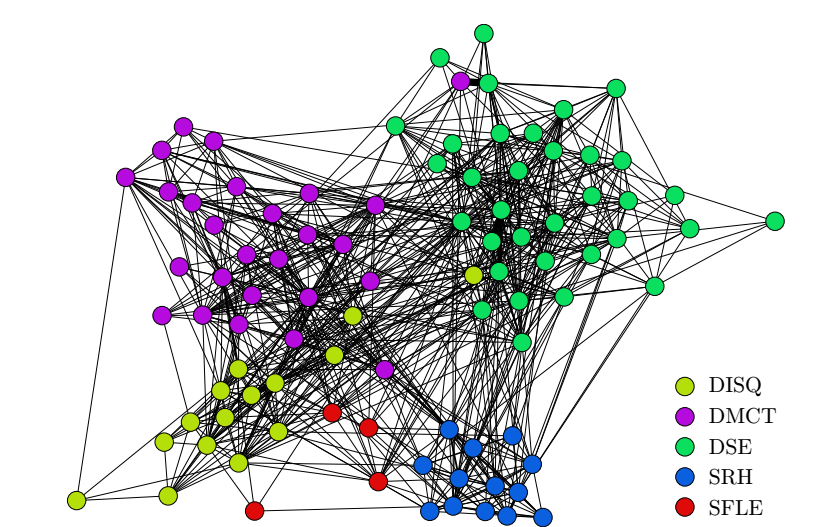Office Networks Reveal Which Co-Workers To Avoid During Infectious Outbreaks
The way disease spreads through society is currently the subject of significant interest, not least because of the recent, frightening outbreaks of ebola and various strains of bird flu. One hope is that a better understanding of this process can lead to more efficient and cost-effective methods of vaccination.

Last week, we looked at just such a study of interpersonal contacts within schools. This suggested that an effective way to prevent an epidemic would be to close a single class rather than the entire school.
Today, Mathieu Genois at the University of Toulon in France and a few pals study the pattern of face-to-face contacts in an office building and say that this too suggests a novel and cost-effective vaccination strategy for preventing epidemics.
The team studied the face-to-face interactions over two weeks between people working in an office building belonging to the French Institute for Public Health Surveillance (the InVS) near Paris. The building hosts three different scientific departments along with a human resources fepartment and a logistics department.
Workers within the building were given wearable sensors that detect the close proximity of others nearby. Since the body acts as a shield at the radio frequencies used by the sensors, the devices only detect contacts when people face each other at distances of less than 150 centimetres. In total, the team distributed 100 of these sensors to the two thirds of the staff who agreed to take part.
The team studied the nature of contacts by drawing up a network in which each individual is a node and a line between them represents a contact at least once during the period of data collection (see above).
The most striking aspect of this network is that the individuals are generally clustered according to the department in which they work. In other words, most people have most contacts with colleagues in their own department. What’s more, they have contact with around 15 other individuals on average, a small fraction of the total office population.
There are a few exceptions, however. A small number of individuals have most of their contacts in other departments. The team call these people ‘wanderers’. It is easy to imagine that when it comes to the spread of disease, wanderers turn out to be important. In fact, that is not the case because although wanderers have most contacts outside of their department, these contacts are confined to limited groups of other people.
Genois and co say there is a much more important group of people, who they call ‘linkers’. These are defined as people who have about half of their contacts within their own department and half outside it. “Linkers act as bridges in the network,” they say, and so are most likely to spread disease.
Indeed, Genois and co simulate the spread of disease using standard models of infection and show how linkers play a key role.
That points to an interesting strategy. Instead of vaccinating everybody, or vaccinating people at random, an efficient, low-cost way of preventing the spread of disease is to vaccinate only those people classed as linkers. “A vaccination strategy targeting linkers efficiently prevents large outbreaks,” they conclude.
One potential problem is identifying linkers. This can be done by carrying out the same kind of network analysis that these guys performed. However, this is time-consuming and expensive.
A much easier way is to identify linkers from their job descriptions. For example, the person who pushes the sandwich trolley or mail cart from one department to another might be an obvious target. “This result might help the design of efficient, low-cost vaccination strategies,” they say.
It also suggests mechanisms that individuals can use themselves to help prevent infection. If you know who the linkers are in your office, one strategy to avoid coming down with flu this winter would be to avoid them, the so-called social distancing strategy.
That is interesting work that provides some fascinating insight into the microstructure of social contacts within office buildings. In particular, it reveals that a major factor is the organisation of offices into departments. That is in stark contrast to many other social situations and certainly to the assumption sometimes made in the simulation of epidemics, that contacts are homogeneous within buildings.
This kind of work may seem academic but the truth is that, with the first diagnosis of ebola on American soil this week, strategies for avoiding infections at work may become a necessary part of office life.
Ref: arxiv.org/abs/1409.7017 : Data on face-to-face contacts in an office building suggests a low-cost vaccination strategy based on community linkers
Keep Reading
Most Popular
Large language models can do jaw-dropping things. But nobody knows exactly why.
And that's a problem. Figuring it out is one of the biggest scientific puzzles of our time and a crucial step towards controlling more powerful future models.
How scientists traced a mysterious covid case back to six toilets
When wastewater surveillance turns into a hunt for a single infected individual, the ethics get tricky.
The problem with plug-in hybrids? Their drivers.
Plug-in hybrids are often sold as a transition to EVs, but new data from Europe shows we’re still underestimating the emissions they produce.
Stay connected
Get the latest updates from
MIT Technology Review
Discover special offers, top stories, upcoming events, and more.